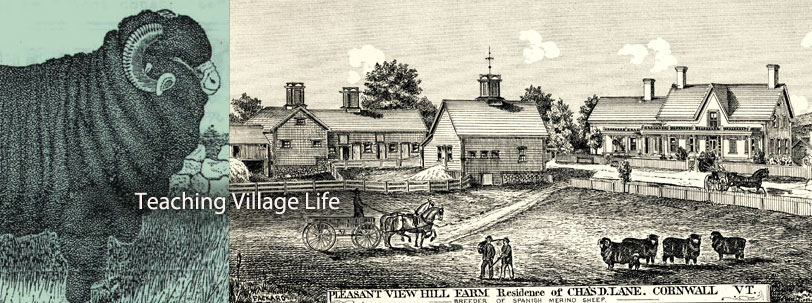- How did farming change the land?
- What was the role of barter in the village economy?
- How did women’s work change?
Unit Frame
Here is a unit frame outlining an approach to teaching about village life in 19th-century Vermont and New Hampshire. For a similar unit frame about the founding and early settlement of these towns, see the Flow of History’s Early Settlement Toolkit
| Topic/Title | Village Life in Vermont and New Hampshire |
| Overview | This unit investigates the formation and evolution of communities in Vermont and New Hampshire through the middle of the 19th century, with an emphasis on settlement patterns, landscape change, and economic development. |
| Enduring Understandings |
|
| Essential Question |
|
| Focusing Questions |
|
| Background Information | Freedom and Unity: Building Communities Vermont History Explorer: Maps |
| Suggested Resources | Children’s Books:
Background Reading:
Primary Sources:
|
| Content Grade Expectations for Vermont | |
H&SS3-4:8 Students connect the past with the present by…
|
|
H&SS3-4:9 Students show understanding of how humans interpret history by…
|
|
H&SS3-4:11 Students interpret geography and solve geographic problems by…
|
|
H&SS3-4:12 Students show understanding of human interaction with the environment over time by…
|
|
| Inquiry Grade Expectations for Vermont | |
| Students initiate an inquiry by. Asking relevant and focusing questions based on what they have seen, what they have read, what they have listened to, and/or what they have researched. |
|
| New Hampshire Curriculum Framework: Social Studies | |
| SS:EC:4:2.1: Explain why needs and wants are unlimited while resources are limited. (Themes: C: People, Places and Environment, D: Material Wants and Needs) | |
| SS:EC:4:3.1: Illustrate cycles of economic growth and decline, e.g., New Hampshire manufacturing or agriculture. (Themes: D: Material Wants and Needs, F: Global Transformation, G: Science, Technology, and Society) | |
| SS:EC:4:4.1: Describe different methods people use to exchange goods and services, e.g., barter or the use of money. (Themes: D: Material Wants and Needs) | |
| SS:GE:4:1.5: Recognize the causes and consequences of spatial interaction on Earth’s surface, e.g., the origin of consumer goods or transportation routes. (Themes: C: People, Places and Environment, D: Material Wants and Needs, F: Global Transformation) | |
| SS:HI:4:4.3: Investigate the evolution of the United States economy, e.g., the transition from farms to factories or the trend from small local stores to shopping malls. (Themes: D: Material Wants and Needs, G: Science, Technology, and Society) | |
| SS:HI:4:5.3: Trace the changes in the roles and lives of women and children and their impact on society, e.g., the family or the workplace. (Themes: B: Civic Ideals, Practices, and Engagement, I: Patterns of Social and Political Interaction) | |
